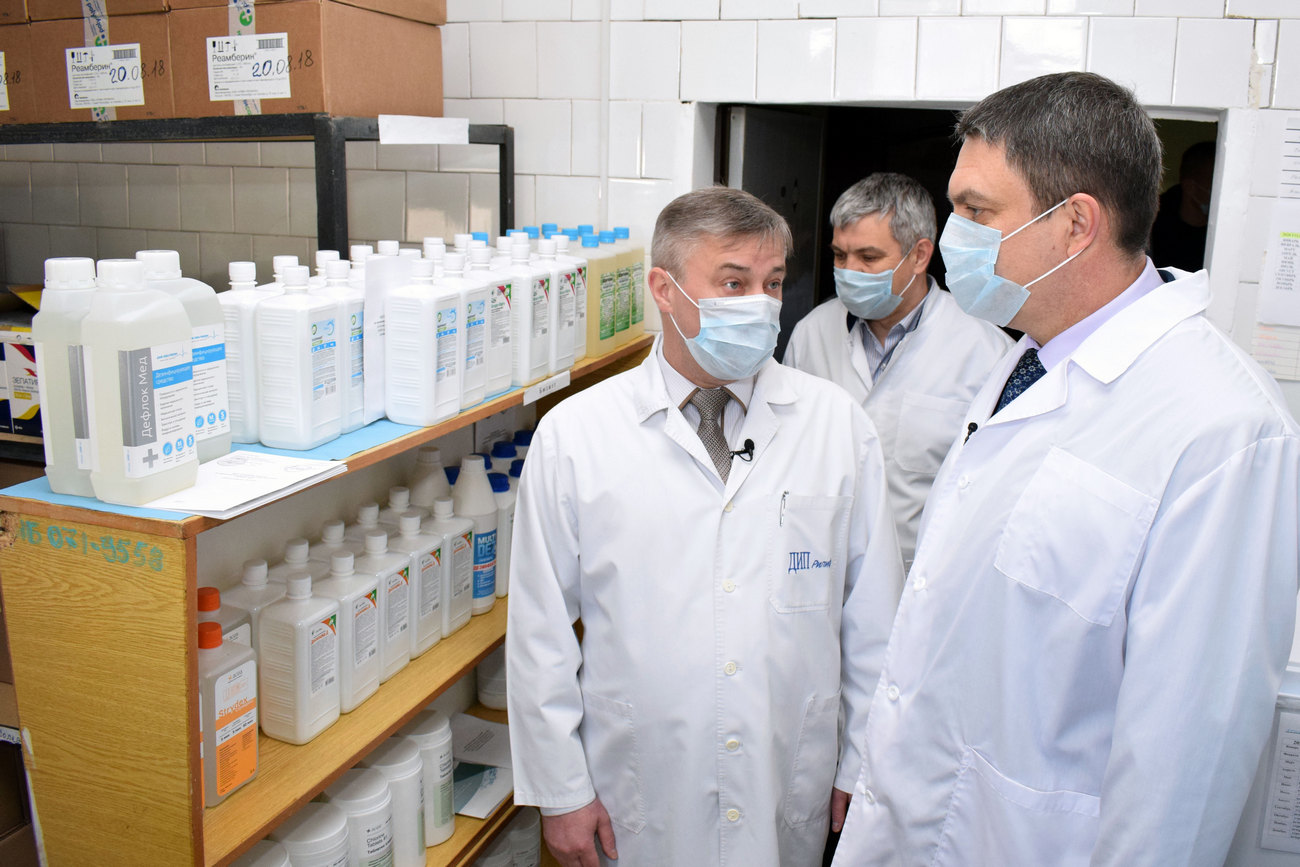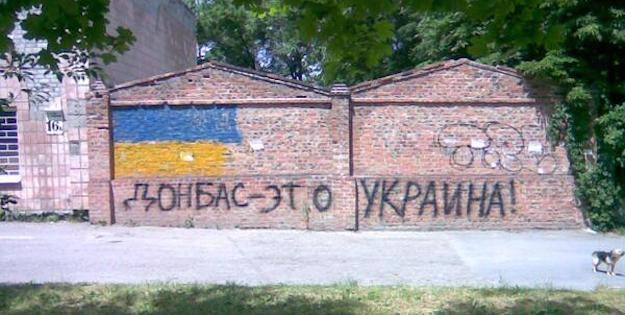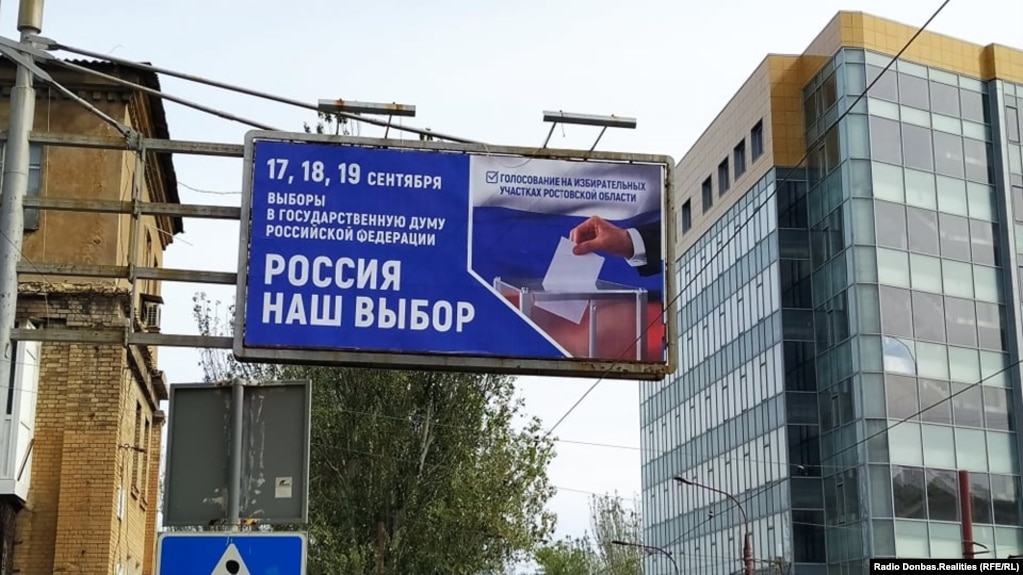According to them, almost in the center of Donetsk, terrorists are not just physically exterminating people, but also morally drain them. To force confessions, the guards beat prisoners, torture them by electrocuting, and then harass them on a daily basis, forcing to work hard, imitating executions, and raping them in front of other inmates.
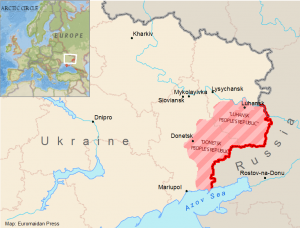 Over the five years of its existence, several hundred people – both militants and locals suspected of spying for Ukraine – went through the facility. In particular, for 28 months, terrorists held journalist and blogger Stanislav Aseyev.
Over the five years of its existence, several hundred people – both militants and locals suspected of spying for Ukraine – went through the facility. In particular, for 28 months, terrorists held journalist and blogger Stanislav Aseyev.
Most of former Izolyatsia-held hostages prefer not to mention what they have experienced here. Not only because the memories are unbearable, but more importantly, in order to prevent their relatives from learning extra details. However, several former hostages interviewed by Ukrainska Pravda agree that it is important to record the truth in order to punish the executioners sooner or later.
That is why they describe in detail, although sometimes anonymously, the premises of the prison, the conditions of imprisonment, and the names of those who were killing them.
“Isolated art”
Donetsk, 23 April 2014. Russian tricolors are already fluttering downtown as militants are removing Ukrainian flags from buildings; unknown armed people are controlling the building of the Donetsk Regional State Administration.
And only ten kilometers away from the city center on the premises of the art platform Izoliatsia, the first Ukrainian literary festival is ongoing, attended by writers, artists, filmmakers from all over Ukraine: Myroslav Marynovych, Irena Karpa, Yuriy Vinnychuk, as well as foreign guests. British journalist and writer Lily Hyde was among the latter.

Now she recalls how she had visited the building of the Donetsk Administration between the discussions and saw offended people who repeated that they were not heard in Kyiv.
“Instead, the festival was an island of culture. At the time, everyone hoped that the situation could be improved through art events, without propaganda,” she recollects.

The art project Izoliatsia kicked off in 2010 on the premises of the former Insulation Materials Plant. Since then, the initiative group had organized dozens of meetings and exhibitions. One of their last events was the literary festival.
“At the time, we wanted to show that people who took over the buildings do not represent all of Donetsk. As some people in the plazas shouted “Russia! Russia!” others said that no one was waiting for Russia in Donetsk. Donetsk was a Ukrainian city where everyone was free to communicate and exchange thoughts,” says Mykhaylo Hlubokyi, the director of development and communications of the Izolyatsia Foundation.
He recalls how in order to balance off views Fedor Berezin, a pro-Russian Donetsk writer, received an invitation to participate in the festival. The one who wrote that the Soviet Union had won the Cold War.
“There should have been a discussion. We didn’t know that Berezin had already become the ‘DNR Deputy Minister of Defense’,” adds Mykhailo.
On 9 June 2014, armed men got into the factory, with Battalion Vostok militants among them.
“They showed a piece of paper that was reading: the factory’s eight hectares are now owned by the DNR,” Hlubokyi continues. “They said that they were going to store humanitarian aid from Russia at Izolyatsia, but would have allowed us to work alongside them.
“Of course, no one was going to partake in this – Izolyatsia’s administration informed the public on the seizure, and the militants soon banned everyone from entering the premises of the factory. Most of the possessions and collections remained there,” Mykhaylo notes.
Artists believe that one of those who organized the seizure of Izolyatsia was Roman Liahin, head of the so-called DNR Central Election Commission, who was a regular exhibition-goer prior to that. It was he and Stanislav Slepnev nicknamed the “Mongol” (the last one before the war to head an organized criminal group, which became part of the so-called “Special Operations Center” of fighters), commanded the seizure process on June 9.
Watch also: DNR Paramilitaries talking about IZOLYATSIA (2014)
Militant base
After the seizure, the site for open discussions turned into a restricted secret facility of the “DNR’s Ministry of State Security” (MGB), where not only humanitarian but also military aid from the Russian Federation was concentrated – weapons, equipment, troops.
And they also began to hold illegally detained people there.
“Today the place’s name is not to be pronounced aloud in Donetsk. Even if one of the acquaintances gets there, their relatives call it [euphemistically] ‘where people disappear.’ It is, indeed, a cursed place, it is scary,” says a resident of Donetsk.
Oleh from Mariupol was released during the exchange on 29 December 2019. He is sketching a notional plan of the premises at the request of Ukrainska Pravda. He starts with the building of the factory’s office. Here the militants equipped the ground floor with prison cells. Initially, there were five of them, and three more later on. Each could accommodate 4-20 people.
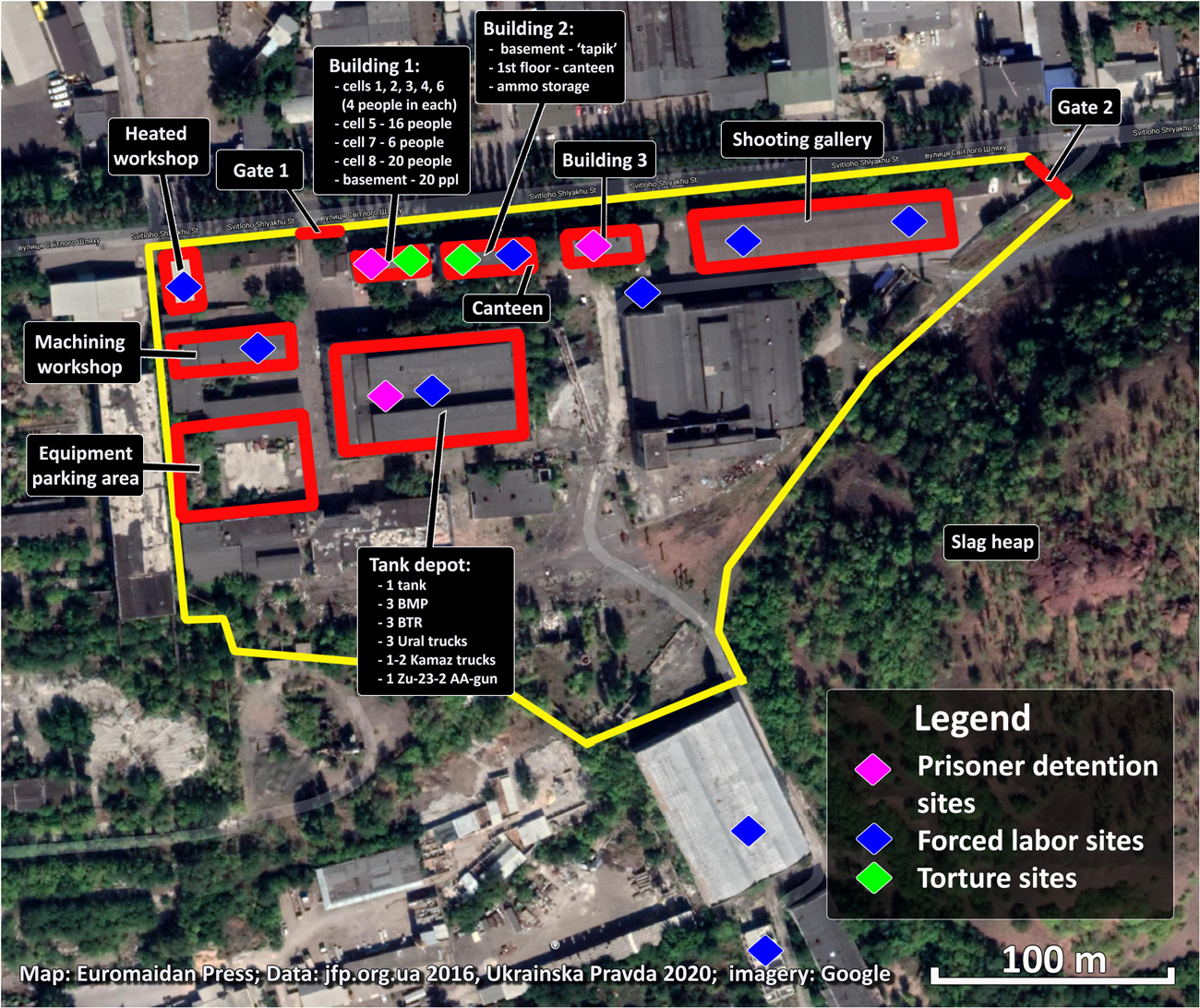
“The latticed windows faced the Svitloho Shliakhu street. Nobody could see what was going on inside, the glass was painted white. The beds were makeshift, made of iron angle bars with wooden doors and mattresses on them. CCTV everywhere, we were watched 24 hours a day,” says the former hostage.
Another prison cell is in the basement.
“Almost everyone kept at Izolyatsia ended up there,” the former hostage continued. “Some people were held in there for a year, some from a few weeks to a month.”
“The basement is scary. Drinking water is given scarcely, and they don’t escort you out to the toilet room. Huge fans are droning all the time. Their noise and lack of air make the head unbearably aching. You never know what time it is and even the date.”
On the second floor, there is a room where the guards and the so-called management lived.
Another building stands to the right of the office. Home to various activities and a cafe in times of past artistic life. The militants made a dining room for themselves there. In the basement under it, they made an interrogation room.
Along the opposite street, there are hangars with military equipment, fuel depots, weapon storages.
“I saw tank shells, [and] 122 and 152 mm caliber rounds for artillery systems. 40-50 boxes each. If something accidentally hits there, it will take down the entire Izolyatsia at once,” says Oleh.
The released hostages say that at Izolyatsia the militants were occasionally trained.
“They came from the Lake, a base of so-called special operations forces commanded by former Oplot (a pro-Russian gang – Ed.) member Vasily Yevdokimov with the call sign Lenin,” says another former hostage, Oleksandr, “Young people aged 20 to 30, their Russian accent was a dead giveaway. But we didn’t exist for them, as we worked they didn’t pay any attention to us.”
Almost all prisoners held at Izolyatsia were involved in forced labor. When militants were going to depart to drills or to the front, the prisoners loaded weapons. And they were forced to collect scrap metal, dismantle buildings to bricks, clean the yard every day of snow, dust, leaves, work in the kitchen, look after farm animals. The militants kept there about 200 pigs, leaving alone chickens, ducks, turkeys, nutrias.
And they also washed the floor and walls after the tortures.
Daily humiliation
“’Take him to the fifth hut,’ I heard. I didn’t realize where I was because of the plastic bag on my head all the time,” recalls Stanislav Pechonkin, a former civilian hostage from Horlivka, “I heard the door open. I realized there were people in the room around me.”
Later, he learned that the rules were as follows: when the door opens, you must turn to set your face towards the wall, lay your hands behind your back, put on a bag.
“I was set to a ‘swallow’ position – a pose near a wall with legs and arms wide apart. It is difficult to stand this way, your hands immediately go numb.
“The one who escorted me ordered the cellmates to ‘press’ me – disallow me from eating, drinking, sleeping. From time to time, someone was hitting my legs and ribs, asking how I cooperated with the SBU (security service of Ukraine, – Ed.), spied, and revealed the “DNR” secrets.”

And Pechonkin says he actually had cooperated with the SBU. Back in 2014-2015, a year before his “arrest,” he told them what was happening in the occupied Horlivka. However, he was taken hostage because of an occasional photo he took on the street.
Eventually, Stanislav decided to confess. He was stripped of the bag on his head and placed at the table. Then he saw what his cell looked like: there were eight people – four “spies and saboteurs,” and three more were local entrepreneurs who supported the “republic.”
“For the prisoners to ‘recall better,’ they brought them to the ‘cafeteria,’ an interrogation room,” Stanislav explains, “There was a ‘tapik’ in the basement – a field phone set used to generate the electric current.
”They bring you to the room and tape you with duct tape and food wrap to a special table so that you couldn’t move. They attach wires to your toes or fingers, heels, earlobes. The worst thing was when they did it to your anus or the genital area, or for women to their breasts.
“What you feel in these “procedures” can’t be compared to anything…
“It feels like one but very strong convulsion is pervading through the whole body. Hellish pain that leaves deep burns on your body in memory of itself. People often can’t stand it, losing consciousness. And everyone is very quick to confess their activities, to make up anything they never did just to end this horror.”
A doctor was always in the basement. Or a person considered to be a doctor. He, according to the testimonies of former prisoners, resuscitated those who have gone unconscious – he gave smelling salts and even chocolate.
“Their goal wasn’t to kill, it was important to force confessions at this stage,” believes Oleksandr.
“Their chief was wondering why I didn’t go unconscious. Others did it several times during a “session,” but never did I. I didn’t want to reveal the secret that I was trained as an electrician in a technical school, and had already experienced it in my life. I knew that it is the current that flows through the heart that can kill you. That’s why I was not afraid. Others were losing consciousness from fear,” says Oleh.
Oleksandr continues,
“If only they stopped torturing you after your forced confessions! But we were under everyday moral and physical terror. I remember hearing the steps down the corridor and thinking, ‘Let it be not after me.’
“They open iron doors and get a victim out to beat with fists, feet, a baseball bat, a gun-butt. In cells, in corridors, at work. Day and night. Up to the point when they break your ribs or you lose consciousness. Some couldn’t survive it. But we don’t know the first or last names of those killed.”
Pechonkin recalls how he was brought to the courtyard for fun in the cold season, stripped of his clothes – initially beaten, and then poured with icy water from a car wash gun saying “you’re dirty.” And it was done by both the warders and some prisoners.
Not only the so-called political ones – ‘spies and saboteurs’ – but also the members of illegal armed formations were held in prison. In particular, Stanislav Aseev mentions them in his manuscripts,
“Their cronies – the so-called ‘militia’, the staff of the ‘ministries’ and others were real ‘meat’ – training material that could be literally hammered into the floor without worrying about any consequences.”
At the same time, according to Aseev, the Izolyatsia administration was well aware that there would be no punishment for abusing their cronies.
“Izolyatsia was a difficult test for me, because when you hear someone being tortured, the duct tape being unrolled, people screaming, you get a scare. It’s scary because you can’t do anything.
“Only sadists can safely hear and see it all. And those just happened to be [in charge of] Izolyatsia,” says hostage Valentina Buchok, released in December 2017.
“Palych”
For a long time, someone having the call sign Palych or Pervyi (“First”) was considered to be the chief of Izolyatsia. This is how the terrorists called him. The prisoners also could hear his allegedly real name – Denis Pavlovich Kulik (Kulikovsky).
After their release, some hostages recognized him on a photo. However, “Palych” is much younger in the only available image.

“In 2017, he was about 35, but he looked awful. We used to call him a seal among us, [since he was] obese, with oedemas [on his face] possibly due to constant alcohol use, with bald patches,” this is how Valentina Buchok describes him.
Pechonkin gives more details about Palych,
“He lived in Kurakhovo, joined the militants in 2014. Before that, he worked either in a pre-trial detention center or in a penal colony (a type of prison in Ukraine – Ed.). He knew all sorts of gangster things, tried to impose criminal-world prison rules. When drunk, he had sadistic manners.
“It was prohibited to greet such people by shaking hands with them, to eat at the same table with them. Even the militants had no right to beat them using their hands. As a punishment measure, you could be put to sleep next to them.”
Stanislav Pechonkin was held at Izolyatsia until the end of August 2017. Due to his poor health, he was transferred to the Donetsk pre-trial detention center.
“And on the previous day, Palych celebrated his birthday,” he recalls. “The celebration lasted for several weeks. But the pinnacle of the harassment was on 12 August 2017, when our Cell 8 was brought for execution.
There were ten of us in total. At first they forced everyone to sing songs for Palych’s guests, “Arise Great Country!” (WWII-times Soviet propaganda song, – Ed), “Forget you everything with me” (1990s ballad by the Russian punk group Sektor Gaza, – Ed.), then they started beating us up.
“Pervyi” and his guests, including a doctor, were sitting at the table. Subsequently, Palych shouted, “Execute them by shooting!” They brought us to our knees. A guard clicked several times [with his assault-rifle’s breech-mechanism]. There was no shot. And they started to pour [alcohol] for guests.”
Palych ruled Izolyatsia until February 2018. After another beating of one of the prisoners, he was ousted to be replaced by a Russian citizen (call sign “Kuzmich”) and Palych’s deputy “Yuri the Tanker”.
Cooperation with militants
At different times, 10-70 people were kept at Izolyatsia. And they were guarded by five to seven guards.
“Among the prisoners were those who cooperated with the administration. For example, in my time there were two entrepreneurs – Andriy and Valentyn. After my release, I asked the SBU about their fate because I knew that these people were released and then found themselves in government controlled territory.
However, I received a reply that the facts I provided about their involvement in torturing were not confirmed,” says Buchok.
But the most often called name, when it comes to cooperation with the administration, is Yevheniy Brazhnikov. For example, Pechonkin says that it was Brazhnikov who poured cold water and beat people to force confessions.
“I still can hear the voice, ‘Oleh, I’m coming to you’,” says the Pechonkin, “It was Brazhnikov in the cell who wrote down my ‘confessions’ with his own hand, I saw these papers in the ‘case’ file.
“Brazhnikov and I worked in the kitchen. My job was to carry a huge pot of porridge from cell to cell at lunch-time. When we approached a cell where a ‘lowered’ was held, the latter had to say the phrase before getting swill, ‘Mister Chief, (addressing the guard) let me make my friend a New Year’s gift – my jacket.’ The ‘friend’ was Bryaznikov, who, finally, had the guy’s jacket on New Year’s Day. Brazhnikov took it, put it in his cell,” Oleh adds.
Yevhenyi Brazhnikov, a former law enforcement officer, retired from law enforcement in the late 2000s.
“In 2014, he became an active participant of the ‘Russian Spring,’ was active helping pro-Russian rallies, attacked participants of pro-Ukrainian demonstrations. In particular, on 13 March 2014 when [pro-Ukrainian local activist] Dmytro Cherniavskyi was killed,” says Stanislav Pechonkin..
“Then Brazhnikov took the [Ukrainian] red and black flag from the protesters and covered his toilet drain tank with it, so to say, this is where it belongs. Evheniy told about it at Izolyatsia himself. And I later found it on the Internet.”
In addition, Brazhnikov actively communicated with people who supported the militants, such as Fedor Berezin, Anatolii Shariy. He bought things for terrorists in Sloviansk [first Donbas city to be occupied by Russian forces in April 2014] such as optical sights, thermal imagers, as he told back then at Izolyatsia.
“Militants detained Brazhnikov for firearm dealings because he failed to reach a deal with MGB. When I personally met Brazhnikov on Izolyatsia, I already knew that he was a separatist. But at first, I even felt sorry for him, he said, he believed in the “republic” but was deceived. Yet later I saw him beating people not by order but on his own free will,” Pechonkin says.
Ukrainska Pravda reached Yevhenyi Brazhnikov who was also released at the exchange on 29 December 2019 and is currently in Ukraine-controlled territory. Brazhnikov explained that under such conditions different people may behave differently.
“For the record, everyone who was forced to work cooperated with the administration. Some even raped prisoners by guards’ orders. Those released dreamed to forget what happened at Izolyatsia . And now some people are recalling it,” he says and assures that he is ready to meet with law enforcement officials if they wish to question him.
The International Court of Justice in The Hague
Stanislav Pechonkin mentions how shocked he was when he got to Izolyatsia.
“Suddenly you get into an atmosphere of constant moral terror. And then you even get used to it,” he said.
The events that take place in Donetsk at the former insulation materials plant should be judged by a court, be it Ukrainian or international.
According to Vitaliy Khekal, a lawyer at the Ukrainian Legal Advisory Group, the Izolyatsia developments can be classified by the European Court of Human Rights as a violation of the Convention on Human Rights, namely as torture and ill-treatment that degrades human dignity.
“Besides, the SBU is now investigating a large Donbas events case,” adds Khekalo, “And it probably also addresses the events that happened at Izolyatsia. Further on, the Ukrainian side gradually submits some materials to the International Criminal Court in The Hague, while other [materials] are considered at national level as separate proceedings,” says Khekal.
Read also:
- Displaced art. The IZOLYATSIA art center, having fled occupied Donetsk, flourishes in Kyiv
- “Russians taught how to torture.” Ex-captives of Donbas “republics” share horrors of basement prisons
- BBC: How the “DNR” special services & troll factory scare Russians with terror attacks
- Prisoner exchange between Ukraine and Russian occupation authorities in Donbas underway – PHOTOS
- Ukraine swaps 127 prisoners including defendants of Maidan massacre to 76 Ukrainians held in occupied Donbas
- Ukrainian civil resistance to Russian occupation in Donbas
- Human rights NGO reports on 119 known hostages behind bars in occupied Donbas
- Torture and humiliation: freed Ukrainians talk about Donbas captivity
- “Our men are rotting alive!”- say wives of Ukrainian POWs held in “DNR/LNR”
- Largest prisoner swap in Donbas: 73 Ukrainians released from captivity of Russian-run “republics”





